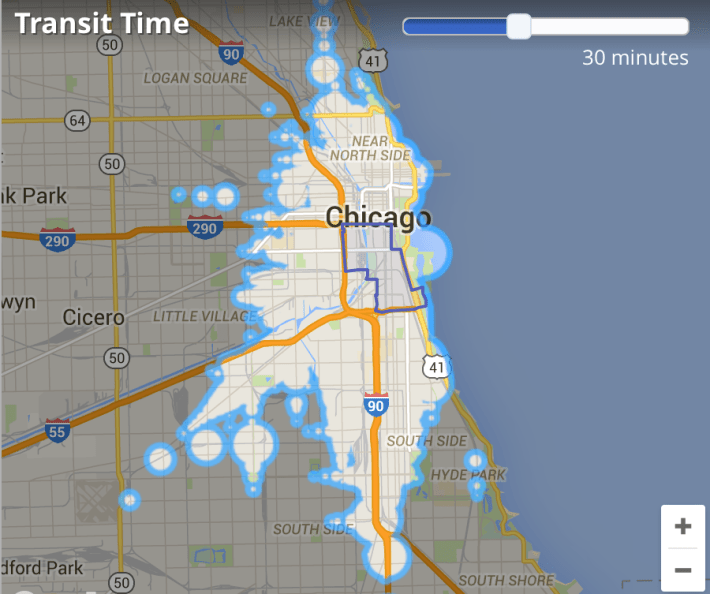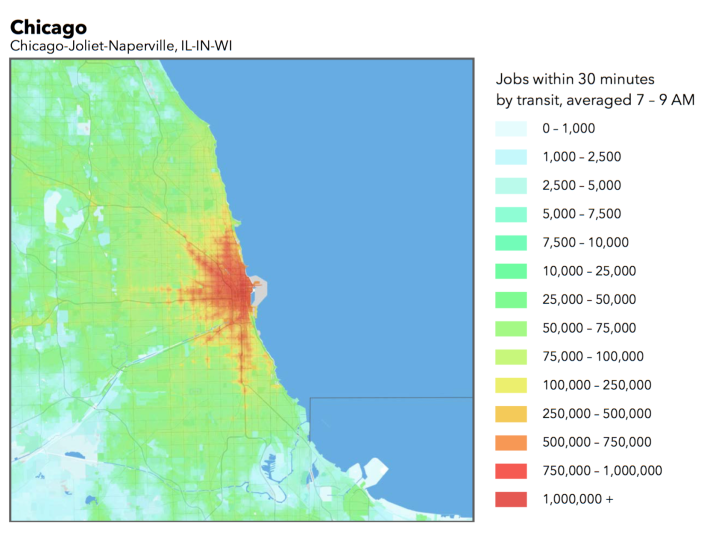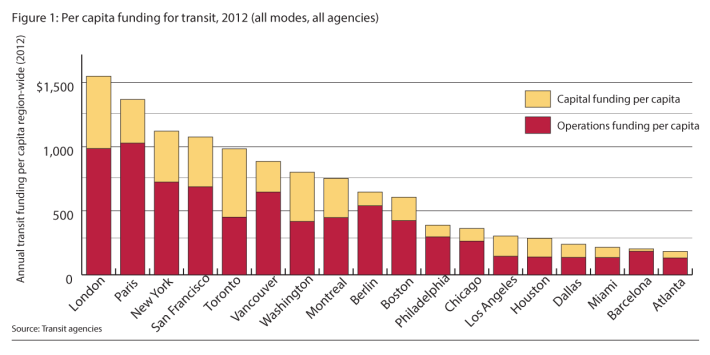
A recent analysis of transit service in United States cities found that Chicago ranked #6, behind New York City, San Francisco, Boston, Washington, D.C., and Philadelphia. Transit Score, from the Walk Score company now owned by the realtor Redfin, reviewed public schedules data provided by the transit agencies in each city to study how often trains and buses come to stops near people's homes.
Analysis from other organizations used different methodologies but made similar conclusions. Regardless of our ranking, transit in the city of Chicago and the region looks to be behind its peers.
Redfin spokesperson Alex Starace said that "for its size...Chicago is lagging in transit options and efficiency." One reason that could explain why Chicago ranks sixth is that the Transit Score methodology give twice as much weight to run schedules at train stations as bus stops. Chicago has over 10,000 bus stops, and dozens of CTA and Metra train stations that are separated from residences by highways and in low-density areas. Additionally, many Metra stations on the South and West sides of Chicago have low service frequency.
"Rail better than bus"
Their reasoning in weighting this is to essentially say that people are better served by trains than buses. Starace said that the Walk Score advisory board provided input on that decision, describing further that, "bus lines are generally not as valuable as rail lines" because "they’re subject to move or change, which means that no real estate developer would invest in land because it’s near a bus line."
Additionally, Starace said, "buses, more so than rail, are generally subject to vagaries of prevailing traffic, making their timing, speed and reliability lower than those of rail lines," and that even if you run larger buses, they "generally hold far fewer people than a rail line can."
But no developers? There's a lot more at stake than whether a parcel they want to develop is near a train or bus stop. Is building at Western and the Eisenhower superior to Western and North because the former has a Blue Line station? Existing real estate developers in Chicago currently attract tenants by marketing the nearby express bus routes the CTA runs to north and south lakefront neighborhoods.
Where Chicago ranks, though, is perplexing because none of Chicago's rail transit lines run in mixed traffic like the light rail trains and streetcars in San Francisco, Boston, and Philadelphia, all of which got the same 2x weight as CTA and Metra stations. Those light rail trains and streetcars are subject to the same "vagaries of prevailing traffic" as buses.
So, even on a route that has subway-like service, which a bus rapid transit project on Ashland Avenue would bring, in the form of dedicated lanes, priority at traffic signals, and prepaid and all-door boarding, Transit Score would still only consider its frequency and stop location. San Francisco and New York City have both made strides to speed up bus service by converting travel lanes to bus-only lanes on some streets, but these still get counted as half a train station.
Transit Score isn't alone
There are other ways to rank transit service and its effectiveness among big cities. One way is to measure the share of regional jobs that someone could reach riding transit within a certain time period. The Brookings Institution looked at a cutoff of 90 minutes using 2010 data. The Chicago region, they found, is definitely behind the same five cities, and below average for all metropolitan areas in the United States.
To rank higher on the Brookings study means to increase the number of jobs accessible by transit in Chicagoland. We'd either have to build more transit to suburban job centers, which the Center for Neighborhood Technology said to do in its Putting Places First report last month, or move more jobs to transit-served locations.
In a similar vein, the University of Minnesota's Accessibility Observatory designed a new way to rank transit service in metropolitan areas last year. They measured the accessibility – "the ease of reaching valued destinations" – of places via transit. The weight is placed on the time it takes to get to a job, with jobs accessible within 10 minutes given the highest weight. Jobs were given a lower weight for every 10 more minutes it takes to get to them by transit, up to 60 minutes.
In their transit accessibility ranking, the Chicago area got fifth place, after New York City, San Francisco, Los Angeles, and Washington, D.C. Interestingly, for jobs 30 minutes or way or less, Chicago ranked fourth place, likely because the Loop has so many jobs and so many people live close to there.

How to rank higher
For the Chicago metro area to rank higher on the Accessibility Observatory's study, CTA, Metra, and Pace would have to add more runs or speed up runs. Additionally, we could add more transit service to suburban job centers or work with companies to locate their new or expanding businesses near transit – currently, only 21 percent of regional jobs are within 1/4 mile of transit.
The CTA will speed up the local service on Ashland and Western Avenues later this month by consolidating some bus stops. Pace will be adding more frequent service on Milwaukee Avenue between Jefferson Park and Niles, but these improvements won't help to improve Chicago's transit score. Metra has no plans to add more service, and CTA has no other plans.

Accessibility Observatory says their methodology improves upon other studies because it considers the travel time to get to a transit stop, and the waiting once one reaches it. Transit Score considers only the number of times per week a transit vehicle arrives.
By any measure, transit in Chicagoland is far from number one, and the Metropolitan Planning Council said our slow rate of investments in transit service is insufficient to match our metropolitan peers.
![]()
Did you appreciate this post? Streetsblog Chicago is currently funded until April 2016. Consider making a donation through our PublicGood site to help ensure we can continue to publish next year.




